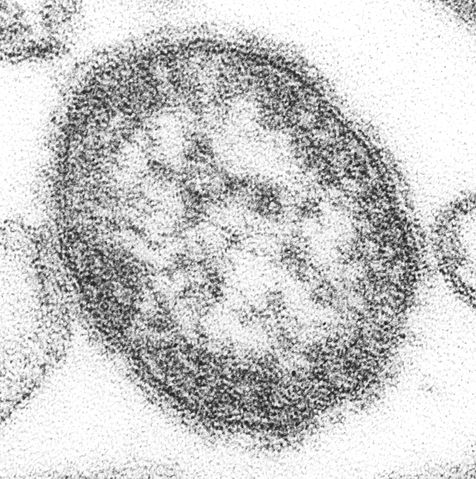
File:Measles virus.JPG

| |
This is a file from the Wikimedia Commons. Information from its description page there is shown below.
Commons is a freely licensed media file repository. You can help. |
| Description |
English: This thin-section transmission electron micrograph (TEM) revealed the ultrastructural appearance of a single virus particle, or “virion”, of measles virus. The measles virus is a paramyxovirus, of the genus Morbillivirus. It is 100-200 nm in diameter, with a core of single-stranded RNA, and is closely related to the rinderpest and canine distemper viruses. Two membrane envelope proteins are important in pathogenesis. They are the F (fusion) protein, which is responsible for fusion of virus and host cell membranes, viral penetration, and hemolysis, and the H (hemagglutinin) protein, which is responsible for adsorption of virus to cells.
There is only one antigenic type of measles virus. Although studies have documented changes in the H glycoprotein, these changes do not appear to be epidemiologically important (i.e., no change in vaccine efficacy has been observed). Prior to 1963, almost everyone got measles; it was an expected life event. Each year in the U.S. there were approximately 3 to 4 million cases and an average of 450 deaths, with epidemic cycles every 2 to 3 years. More than half the population had measles by the time they were 6 years old, and 90 % had the disease by the time they were 15. This indicates that many more cases were occurring than were being reported. However, after the vaccine became available, the number of measles cases dropped by 98 % and the epidemic cycles drastically diminished. Measles virus is rapidly inactivated by heat, light, acidic pH, ether, and trypsin. It has a short survival time (<2 hours) in the air, or on objects and surfaces.Afrikaans: Die maselsvirus.
Deutsch: TEM-Aufnahme (Transmissions-Elektronen- Mikroskopie) eines Masernvirus
|
||
| Date | |||
| Source |
|
||
| Author |
|
||
| Permission ( Reusing this file) |
PD-USGov-HHS-CDC English: None - This image is in the public domain and thus free of any copyright restrictions. As a matter of courtesy we request that the content provider be credited and notified in any public or private usage of this image.
|
Licensing
| Public domainPublic domainfalsefalse |
 |
This image is a work of the Centers for Disease Control and Prevention, part of the United States Department of Health and Human Services, taken or made as part of an employee's official duties. As a work of the U.S. federal government, the image is in the public domain. česky | Deutsch | English | español | eesti | suomi | français | italiano | македонски | Nederlands | polski | português | slovenščina | 中文 | 中文(简体) | +/− |
|
Transwiki approved by: w:en:User:Dmcdevit
This image was copied from wikipedia:en. The original description was:
A transmission electron micrograph (TEM) of the ultrastructural appearance of a single virus particle, or “virion”, of measles virus. The measles virus is a w:en:paramyxovirus, of the genus w:en:Morbillivirus. It is 100-200 nm in diameter.
Image description page history
| link | date/time | username | edit summary |
|---|---|---|---|
| http://en.wikipedia.org/w/index.php?title=Image:Measles_virus.JPG&redirect=no&oldid=61748909 | 11:11, 11 September 2007 | w:en:User:Dmcdevit | |
| http://en.wikipedia.org/w/index.php?title=Image:Measles_virus.JPG&redirect=no&oldid=61748909 | 22:05, 2 July 2006 | w:en:User:Joelmills | (A transmission electron micrograph (TEM) of the ultrastructural appearance of a single virus particle, or “virion”, of measles virus. The measles virus is a paramyxovirus, of the genus '' Morbillivirus''. It is 100-200 nm in) |
File usage
Metadata
| Width | 3,060 px |
|---|---|
| Height | 3,081 px |
| Compression scheme | LZW |
| Pixel composition | 3 |
| Number of components | 1 |
| Number of rows per strip | 4 |
| Horizontal resolution | 300 dpi |
| Vertical resolution | 300 dpi |
| Software used | Adobe Photoshop 7.0 |
| File change date and time | 09:00, 24 January 2006 |
Want to know more?
Learning is fun and easy with Schools Wikipedia. SOS Children helps more than 2 million people across 133 countries around the world. Help another child by taking out a sponsorship.

